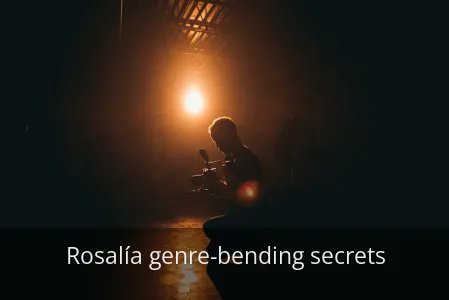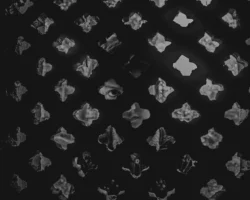
Have you ever listened to a Rosalía track and felt like you were hearing music from the future, a sound so fresh it defies every category you try to put it in?
From the raw, soul-piercing intensity of flamenco to the slick, global beats of reggaeton and the avant-garde textures of electronic music, she doesn’t just mix genres—she melts them down and forges something entirely new.
In this revealing breakdown, we’re going to dissect the exact, unconventional techniques that form the backbone of her revolutionary sound.
You’ll learn the actionable secrets behind her creative process, transforming her artistic alchemy from magic into method.
And pay close attention to secret #3—it’s the linchpin of her entire operation, the one element most artists completely overlook, yet it’s precisely what gives her music its undeniable, viral quality.
The Flamenco Foundation: More Than Just a Palmas Clap

Before we can understand the fusion, we must first appreciate the core ingredient: flamenco.
Rosalía’s genius doesn’t lie in simply adding a flamenco guitar to a pop track.
Instead, she deconstructs the genre to its emotional and rhythmic essence.
She takes the quejío—that raw, guttural cry of pain and passion—and weaves it into her vocal inflections, even when singing over a minimalist trap beat.
It’s the haunting, centuries-old ache in her voice that cuts through the modern production, creating a thrilling and disorienting contrast.
This isn’t cultural appropriation; it’s a deep, scholarly re-contextualization.
Secret #1: The Vocal Mosaic

Rosalía treats her voice not as a single instrument, but as an entire choir.
Her signature sound is built on intricate layers of vocal takes, a technique she honed while studying flamenco’s complex harmonies.
In a track like “MALAMENTE,” you’re not just hearing one Rosalía; you’re hearing a cascade of her voices—some whispering close to your ear, others echoing from a distance, some delivering crisp, percussive ad-libs.
She stacks these layers to create rhythm, texture, and a sense of immersive, three-dimensional space.
This vocal mosaic transforms a simple melody into a rich, polyphonic tapestry that demands repeated listening.
Secret #2: Rhythmic Deconstruction and the “Anti-Dembow”

Reggaeton is built on the ubiquitous dembow rhythm: boom-ch-boom-chick.
It’s a pattern so ingrained in our musical DNA that we feel it in our bones.
So, what does Rosalía do?
She dismantles it.
In “Con Altura,” the dembow is there, but it’s fragmented, chopped, and filtered.
She pulls it apart, leaving ghostly traces of the rhythm that your brain instinctively tries to complete.
This creates a hypnotic, forward-driving tension.
She understands that sometimes, the most powerful beat is the one you almost don’t hear, the one that exists in the negative space, compelling your body to move to fill the void.
Secret #3: The Lyrical Code-Switching (The Overlooked Masterstroke)

And now we arrive at the crown jewel, the most critical yet most frequently ignored element of her success.
This isn’t about sound or rhythm; it’s about language as a musical and cultural weapon.
Most artists who crossover stick to one language or clumsily translate phrases.
Rosalía, however, is a master of lyrical code-switching.
She seamlessly weaves together the deep, poetic slang of the Spanish caló (gypsy dialect), the street-wise swagger of Puerto Rican reggaeton, and the global lingua franca of internet-age English.
Why is this so powerful?
First, it creates instant, multi-layered cultural resonance.
A line like “Un tra tra, un tri tri” from “Bizcochito” is pure, playful onomatopoeia that transcends language barriers, while a deeply flamenco phrase like “a mi la Llorería” roots the song in a specific, profound tradition.
Second, and most importantly, she uses language phonetically.
She chooses words not just for their meaning, but for their rhythmic punch and sonic texture.
The sharp, percussive “t” sounds in “tra tra” act as a drum hit, while the flowing, liquid “ll” in “Llorería” functions like a melodic run.
This is the secret sauce.
By treating language as pure sound, she builds a direct, visceral connection with a global audience that might not understand every word but feels the entire emotional and rhythmic spectrum.
They ignore the dictionary and dance to the phonetics.
Secret #4: The Sonic Collage of Unexpected Sounds

Forget standard synth pads and drum kits.
Rosalía’s production, often in collaboration with El Guincho, is a meticulously curated museum of found sounds.
The screech of a car tire becomes a dramatic riser.
The sound of a motorcycle engine revving transforms into a bass drop.
A sample of a flamenco dancer’s heels is looped into a complex rhythm.
This collage approach injects an element of surprise and raw, real-world grit into the polished world of pop.
It keeps the listener constantly off-balance, engaged in a sonic treasure hunt for the source of each intriguing noise.
Secret #5: Embracing Negative Space and Silence

In an era of music often defined by maximalist production, Rosalía is a bold minimalist.
She isn’t afraid of silence; she wields it.
Listen to the stark, almost empty opening of “A Palé.”
The power of the track comes from the tension between the explosive, industrial beats and the vast, echoing spaces between them.
This use of negative space makes every element that does appear feel intentional, weighty, and dramatic.
It’s a lesson in confidence—knowing that the music isn’t just about the notes you play, but the potent silence you leave behind.
Secret #6: The Visual-Album Philosophy

For Rosalía, the music is only one part of the art.
Every single, from “MALAMENTE” to “SAOKO,” is released with a meticulously crafted music video that expands the song’s narrative.
These aren’t just promotional clips; they are essential chapters in a larger visual album.
The fashion, the choreography, the cinematography—they all serve to deepen the cultural and aesthetic references, creating a complete, immersive universe for the music to live in.
In the age of social media, this multi-sensory approach is not a luxury; it’s a necessity for creating a lasting impact.
The Masterclass Conclusion: Fusion is a Feeling

So, what’s the ultimate takeaway from Rosalía’s genre-bending playbook?
It’s that true fusion isn’t a mathematical equation of “flamenco + pop + reggaeton.”
It’s an emotional and textural experience.
It’s about deconstructing the rules of each genre to their core emotional truth and rebuilding them into a new, coherent language.
It’s about treating your voice as an orchestra, rhythm as a puzzle, language as percussion, and silence as a weapon.
And as we’ve seen, the most overlooked element—lyrical code-switching as a phonetic tool—is often the very key that unlocks a global audience.
The next time you create, ask yourself: Am I just following the rules of a genre, or am I, like Rosalía, building a new world with a language all its own?
From Theory to Track: Building Your Own Hybrid Sound

So, you’re inspired by Rosalía’s genre-bending masterpieces, but how do you translate that intricate theory into your own music?
The secret weapon for any aspiring producer is a pair of high-fidelity Studio Monitor Headphones.
Think of them as your personal audio microscope, allowing you to hear every single layer.
Remember those subtle flamenco palmas buried under a reggaeton beat or the dozen vocal harmonies stacked into a single chorus?
Without crystal-clear audio, those critical details are just a blur.
This is precisely where a workhorse like the Audio-Technica ATH-M50x becomes indispensable.
Its renowned flat frequency response doesn’t add any sugary bass or sparkling highs to flatter the track.
Instead, it gives you the unvarnished truth, revealing every rhythmic texture and melodic nuance exactly as it is.
This honest soundscape is your ultimate tool for deconstruction.
You can finally isolate that specific shaker sound or analyze the exact reverb on her voice.
Armed with that level of clarity, the gap between admiring Rosalía’s techniques and actively applying them in your own sessions vanishes.
Suddenly, you’re not just listening to innovation—you’re reverse-engineering it and building your own.
The right gear doesn’t just play music; it unlocks the creative process.

Leave a Reply